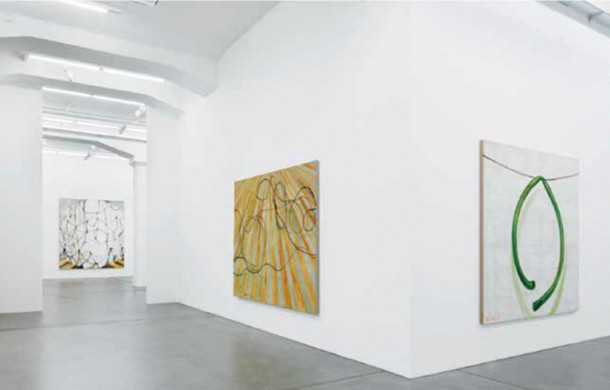ZHANG ENLI: TOPOLOGY
| 2013年05月10日 | 发表于 LEAP 18

PHOTO: Stefan Altenburger Photography Zürich
This gesture sets an example: Hauser & Wirth Zürich shows 17 brand-new canvases by a Chinese painter. A major part of the 2012 production of the Shanghai-based Zhang Enli, these are taken directly from the studio to the eyes of the viewer, who smells the fresh oil paint in the space. For Zhang, this exhibition completes a circuit following solo shows in London (2010) and New York (2011). But that is not all: Hauser & Wirth only recently moved back into their Zürich head office, the restored “Löwenbräu-Areal” (the former premises of the Swiss brewery Löwenbräu), a unique fusion of museums and galleries under one roof. Two months ago Hauser & Wirth re-opened with a solo show of the American performance artist Paul McCarthy, an exhibition that perfectly matched their mission as an art gallery that globally deals with Western post-surrealist post-war art, representing artists like Louise Bourgeois, Pipilotti Rist, Dan Graham, and Dieter Roth.
Consequently, it came as a surprise when the second exhibition was mastered by Zhang Enli. Since 2006, he— together with Indian-born Subodh Gupta— is the only artist on the gallery’s roster who comes from an Asian country, thus serving as a “ticket” to a promising market. Though it is less an Asian clientele that the gallery intends to target with this show than an audience uninterested in the post-socialist realism or performative and activist art often coming from this region, at the same time, it does not want to lose its link to China. Zhang now sophistically fills this market niche.
Since his presence at Art Basel in 2006, his first solo show at Hauser & Wirth in 2007, and an exhibition at Kunsthalle Bern in 2008, the artist has gained quite a reputation in the small though important hub of art and ideas that is Switzerland. However, Zhang Enli’s prominence is based on a solid artistic base, as “Topology” clearly displays: He stays loyal to his subjects— simple over-dimensional every- day objects as balls, tubes, or wires— as well as to his large formats and his medium, the oil painting.
Here, the application of the paint is subtler, faster, and his brushstrokes are more confidently executed than in the past. As with gouache, the colors are applied fluidly and blurred. Hence the undercoated canvas as well as the preparatory drawing always stay visible and have become something of a brand for the artist, even if with his virtuoso alla prima technique he does not need to rely on such auxiliary means.
It is exactly this undercoating of the canvas and prominent grid that are the defining elements in the 2×2 meter painting A Roll of Wires. The regular grid of lines stands in strong contrast to the canvas’ controlling wire that develops its form freely. It is clearly presented without any sketches, in fast and disciplined brushstrokes. Previously applied shades of brown develop both depth and plasticity and offer the illusion that the monumentally enlarged wire hangs on the soiled tiled wall formed by the grid. Zhang Enli rejects any expressionist gesture. He displays the gusto behind every exhibited brush in favor of the picture’s illusion, thus allowing the spectator a view both into the realm of mimesis as well as into the realm of poiesis. This amounts to overkill in The Pattern, a hazy flower arrangement on a towel that sets out to please with its post-impressionist décor. Yet the rougher large-scale works The Cargo and The Cargo (2) successfully transform the vast canvas into a screen for the projection of the viewer’s desires, via a network of elegant brushstrokes. With these, Zhang has produced true masterpieces, works that vindicate his inclusion on the Hauser & Wirth roster. Max Glauner

